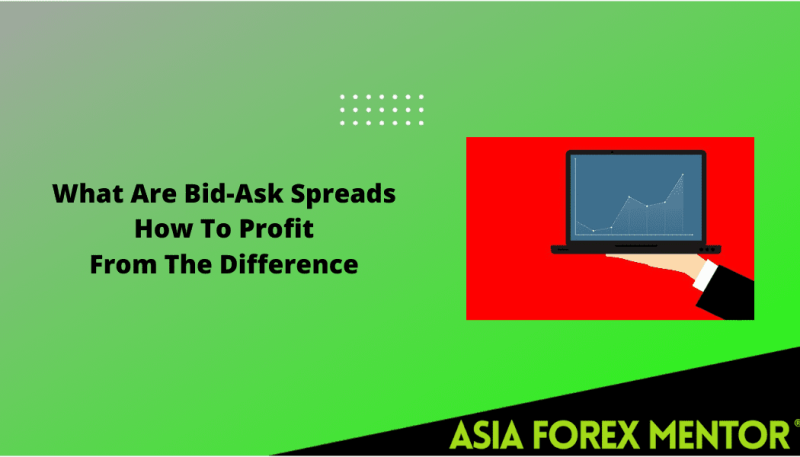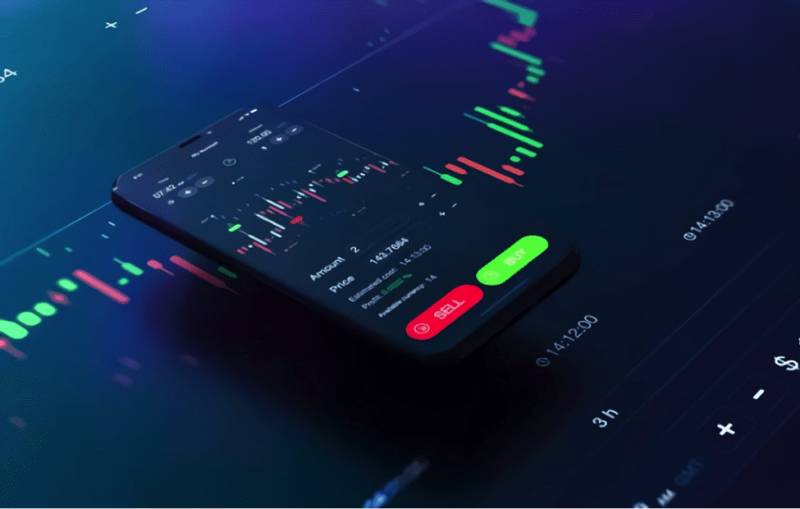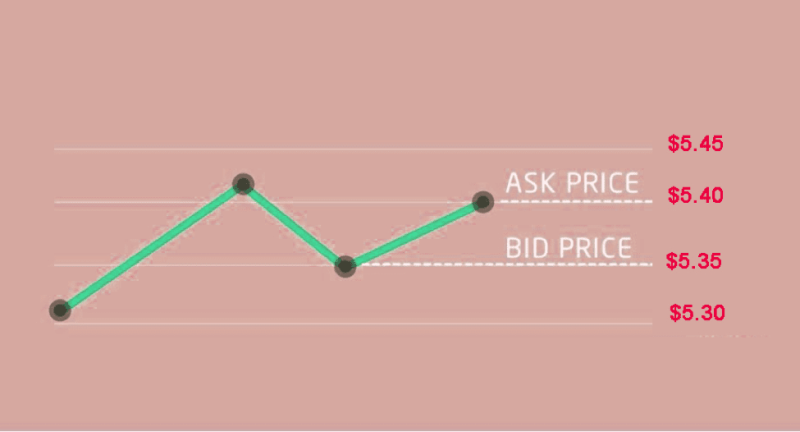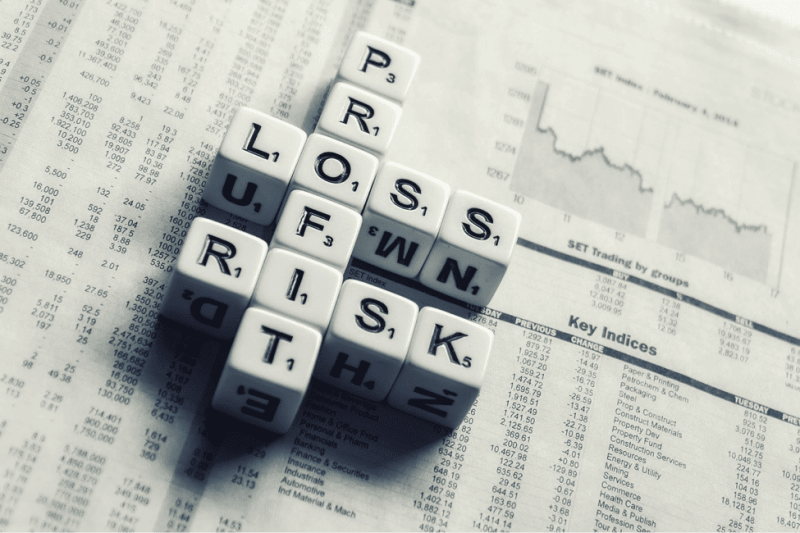
The bid and ask price is basically the most opportune price an investor is prepped to purchase or sell an asset for. The smallest price a trader is prepared to accept for an asset is the ask price, while the bid price is the biggest price a purchaser is ready to pay for a stock.

The contrast in both prices is known as the bid-ask spread. Traders get advised to get a better understanding of the terminology that gets used in the market, before starting to perform transactions with various financial instruments.
Knowledge is always a solid foundation for traders that have to learn how market forces function. The divergence between the bid price and asking price is a crucial elementary theory in investing for buyers and sellers.
The term gets used as a two-way price quotation, which at the same time shows the best price for the sale or purchase of an asset at a specific period. The bid price constitutes the max price a purchaser is going to pay for an asset.
On the other hand, an asking price for a seller indicates the minimum price. A trade happens when an investor is ready to pay the best available buy price or sell at the highest bid.
The spread is the contrast in the purchasing and selling prices, represents the liquidity of an asset. Typically the liquidity is better when the spread is smaller.
Also Read: Copy Trading Software
Contents
- Bid and Ask Explained
- How Are the Bid and Ask Prices Determined?
- The Relation to Liquidity
- Who Profits from the Bid-Ask Spread?
- The Influence on Trading Profits
- Difference Between a Bid Price and an Ask Price
- What If the Bid and Ask Are Close Together?
- Bid-Ask Pricing
- Bid-Ask Spread and Exchange Traded Funds
- Causes a High Bid-Ask Spread
- Example of a Bid-Ask Spread in Stocks?
- Conclusion
- FAQs
Bid and Ask Explained

Traders pervasive the bid and ask spread as the suggested the trading costs. We can examine a hypothetical example to get a better understanding. Let's assume that the present price for the stock of X Computers is $15 / $16.
Trader Joe is planning on purchasing at the present market price and will have to pay $16. However, trader Bob may want to sell X Computers stock at the present price of $16.
The price of an asset is the method by which the market values the asset at any period. Understanding the need to both “bid” and “ask” prices, means learning that two big players are active in every transaction the taker of the price, which is the trader, and the counterparty representing the market maker.
Market makers sell assets at a specific price but at the same time bid to buy at a given price. Investors start a transaction by accepting one of the prices, correspondingly to their plans to buy or sell the security.
The spread is the basic cost of trading which gets accumulated by the market maker via the standard flow of processing orders for the ask and bid prices.
From a certain aspect, the bid-ask spread is a good estimation of the supply and demand for a specific asset. The bid is a signal for the demand, and alternatively, the supply gets represented by the asking price, and when the prices move apart, it signals an alteration in supply and demand.
Bids and asks depth have a big influence on the bid-ask spread. The spread can increase by a large margin if a smaller number of market actors make limited orders to purchase an asset, in effect producing a smaller number of bid prices.
Because of this, it's important to focus on the bid-ask spread when making a buy limit order to guarantee successful execution.
Professional traders can spot risk in the markets and can increase the difference between the bid and ask prices they are prepared to provide at a particular moment. When every market maker performs this for a specific asset, then the bid-ask spread will be larger than the typical size. Some investors attempt to profit from alterations in the bid-ask spread.
How Are the Bid and Ask Prices Determined?
The market determines the bid and ask prices. In other words, decisions made by traders in the market, that reflect purchasing and selling practices on a given asset are a factor. When demand goes oversupply, the bid and ask prices will move upwards.
At the same time, when supply exceeds demand, bid and ask prices will move downwards. The difference between the bid and ask prices are established by the general trading activity of the asset, with larger activity causing a narrow bid-ask spread, and the opposite is also correct.
The Relation to Liquidity
The size of the bid-ask spread between assets varies mostly because of the liquidity variation for every asset. The spread is the assessment of market liquidity. Specific markets tend to be more liquid and this is shown in the lower spreads. Basically, price takers require liquidity, and market makers offer liquidity.
Currency gets perceived as a liquid asset, and the bid-ask spread is one of the lowers for currencies. Alternatively, less liquid assets, have spreads that range from one to two percent of the lowest ask price for the asset.
Bid-ask spreads are an indicator of how the risk that comes with a trade gets perceived by the market makers. Options or futures contracts can have bid-ask spreads that show a larger percentage of their price when compared with Forex. The extent of the spread can get based on liquidity and how fast the prices can alter.
Who Profits from the Bid-Ask Spread?

Market maker's profit as a result of the bid-ask spread. If we come back to our previous hypothetical example where we examine a trade for X Computers stock for $15 / $16. This shows the readiness to purchase at $15 and sell at $16, with the spread between the two shows the profit.
Bid-ask spreads can range by a large margin, relating to an asset and the market.
In times of market turmoil, the bid-ask spread can increase substantially, traders may not want to pay a price over a specific limit, and sellers at the same time will refuse to accept prices under a specific level.
The Influence on Trading Profits
Few types of orders can get made, yet the market order is elemental. Market orders get filled at the most opportune price. When a trader makes a market order to purchase 100 shares of a stock, with an asking price is $11, in that case, the trade gets executed at that price.
It's crucial to learn the influence of the bid-ask spread on earnings. Take into account a stock with a bid price of $20 and an ask price of $21. When a trader makes a market order, they buy at $21.
If the stock increases by 10%, then the bid price goes to $22 and the ask price at $23.1. When the trader chooses to sell with a market order, they will get $22. The profit for the trader is $2.
When a trader plans on purchasing 250 shares of an asset, but presently only 100 shares are offered at the present ask price of $20. The market order from the trader will buy 100 shares at $20, and 150 shares at the next best available price, which will be larger than $21.
If the bid-ask spread is large the trader may decide to make a limit order. The buy limit order gets executed when the security price goes under the specific level, and a sell limit order will get realized when the asset price moves over a specific level.
The limit order is finalized when the price is at or over the asking price, alternatively under or at the bid price. Traders that possess an asset can make a sell limit order when planning to get to a particular profit level.
Also Read: Stock Borrow: How To Use Security Lending for Profits
Difference Between a Bid Price and an Ask Price
Bid prices are the highest bid price an investor is prepared to pay for an asset. Alternatively, the asking price is the lowest sell price the holder of an asset is prepared to sell it for.
When an asset gets traded at an ask price of $40, a trader planning to purchase it must offer a minimum of $40 to buy it at the current stock price. The difference between the bid and ask prices is the bid-ask spread.
What If the Bid and Ask Are Close Together?
An asset is liquid if the bid and ask prices are close, in this case, the asset has a narrow bid-ask spread. Investors benefit from this type of situation because it makes it easier to enter and exit positions, especially with big positions.
However, an asset with a wide bid-ask spread, meaning there is a big difference between the two prices, that that asset can be too costly to trade.
Bid-Ask Pricing
Investors know that the bid and ask prices for security are never identical. Frequently the ask price will be larger than the bid price.
Traders have to pay the asking price when planning on purchasing an asset, and if they are going to sell the asset, they will in return receive the bid price. The spread is the difference between the two and is the profit earned by the investor doing the transaction.
In reality, this is not the clean profits that the investor gets to pocket directly, the sum usually gets used to pay fees to the broker.
Specific corporations labeled as “market makers” set a bid-ask spread by simultaneously offering to buy and sell a particular stock.
The market maker can make a bid-ask spread for an asset as $10.22/$10.24, the first price is what the investor is prepared to pay to purchase the stock, while the second price signals the amount at which the asset can get sold. The difference in the price is the profit for the company.
If you are not implementing market orders it can be difficult to know the price at which, you can buy or sell, considering prices fluctuate for actively traded assets.
Bid-Ask Spread and Exchange Traded Funds
An ETF is a basket of securities, and the spread is a product of the underlying securities. If the securities are liquid, the ETF will be liquid and have a small spread.
But asset classes that are not liquid, will have wider spreads. This will get reflected in the spreads on ETF units.
The expanse of trading the securities in the ETF can influence the spread. For an example of an ETF that invests in foreign securities, conversions in the currencies will create additional costs.
Another factor to consider is the taxes and other regulatory costs and taxes. They vary between countries and before making a trade the taxes that apply in your case must be determined and accounted for in the final cost of the trading activity that you are undertaking.
If a trader is making a substantial purchase of an ETF, for a larger quantity than the available inventory for sale, then the market maker will have to form more ETF units by purchasing additional quantities of the assets. To do this it may be needed to pay higher asking prices.
During periods of heightened market risk, the bid-ask spreads can widen. Forcing market makers to take extra steps to perform trades in times of volatility, and spreads of the underlying securities can get wider.
Causes a High Bid-Ask Spread
Several factors can make for a high bid-ask spread. Liquidity is a primary factor, and if there is a large quantity of liquidity in a specific market for an asset then the spread is going to be smaller. Usually, heavily traded stocks have a lower bid-ask spread.
The opposite can be the case with a high bid-ask on unpopular assets on a specific day. These include small-cap stocks, that can have smaller trading volumes, and demand.
Example of a Bid-Ask Spread in Stocks?
Let's look at an example where an investor is trying to buy 1000 shares of X computers for $100. The investor may spot that 1000 shares are offered at $101. In this case, the market spread is wide by $1. This may look insignificant, but when considering big trades, it can produce a substantial difference, and this is the reason narrow spreads are ideal.
Conclusion
There are other strategies to use with the bid-ask spread, yet traders get advised to work with the tested system that has produced results. Although it can take a little part of the profit. When planning to branch out, perform several test runs with demo accounts before investing real money.
Complex strategies are for experienced traders, and novice investors can create unfavorable positions if they don't know what they are doing. It is recommended to stay away from bid-ask spread options when trading, but with more exposure, every trader can learn how to use them. Yet it's recommended to start with the more basic concept for trading in the market.
FAQs
What is the meaning of bid and ask?
The bid refers to the highest price a trader is prepared to pay to purchase a particular amount of shares at a particular time. Ask denotes the smallest price the investor is ready to sell the stock. Usually, the bid price is lower than the ask price.
Do you buy at the bid or ask?
It's crucial to know that the asking price is usually smaller than the current bid price. When purchasing an asset, the trader pays the asking price and gets the bid price when selling the asset.
Why is the bid higher than the ask?
The price is going to move up if the bid volume is larger, signaling that the selling is stronger.
Is bid or ask higher?
The ask price is always higher than the bid price.

















